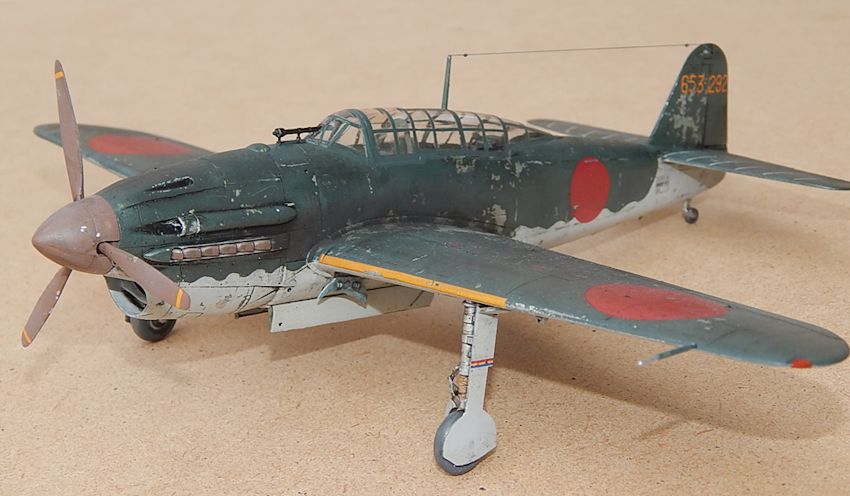
| KIT #: | FB 1 |
| PRICE: | $18.00 |
| DECALS: | Five options |
| REVIEWER: | Pierre-André Boillat |
| NOTES: | Regularly re-released in various versions (inline- and radial engine, night fighter and Kamikaze) |

| HISTORY |
The Kugisho D4AY1 Suisei (Allied codename “Judy”) project
dive-bomber project was launched in 1937 to meet the 13-Shi specifications
issued for a successor to the successful Aichi D3A “Val” design. Chief engineer
Masao Yamana of the First Naval Air Technical Arsenal at Yokosuka was the
appointed chief designer. Unlike most Japanese aircraft of the period, the
engine selected to power the new design was the Aichi Atsuta in-line engine, a
license-built DB 601). The aircraft was of much more modern design than its
fixed landing gear predecessor, an aerodynamically very “clean” all-metal
aircraft with retracting l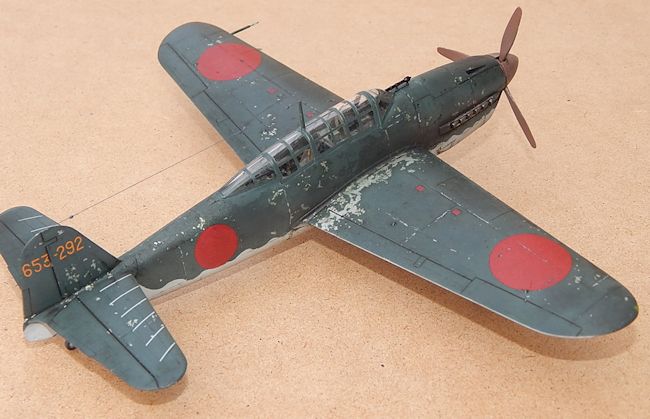 anding gear, carrying its ordinance in a closed bomb
bay.
anding gear, carrying its ordinance in a closed bomb
bay.
First prototype took to the air in December 1940. However, the type encountered several “teething problems” (wing flutter issues, structural weaknesses making dive-bombing hazardous) which delayed mass-production and relegated it to reconnaissance duties. Eventually, the Suisei entered service in significant numbers from mid-1943 only. Likewise, its high landing speed caused the “Judy” to be used mainly from land bases, as it was deemed unsuitable from use on smaller carriers.
Another issue was the in-line Atsuta engine’s poor reliability, which caused the aircraft to go through a major re-design to accommodate the Mitsubishi Kinsei 62 radial engine, giving birth to the D4Y3 model. All in all, a grand total of 2’038 Suisei of all types (including recce, night fighters with a single 20mm “Schräge Musik” cannon and “special attack” versions with rocket boosters to increase dive speed) were built and used on all fronts of the Pacific War, the last ones performing Kamikaze attacks until (and even shortly after, in the case of Admiral Ugaki’s notorious suicide raid on August 15, 1945) Japan’s surrender.
| THE KIT |
According to what I heard, Fine
Molds was founded in the second half of the 1980s by former Hasegawa employees
who wanted to go their own way, producing kits of lesser-known but more
interesting aircraft than the then-mandatory 109s and FW 190s. I c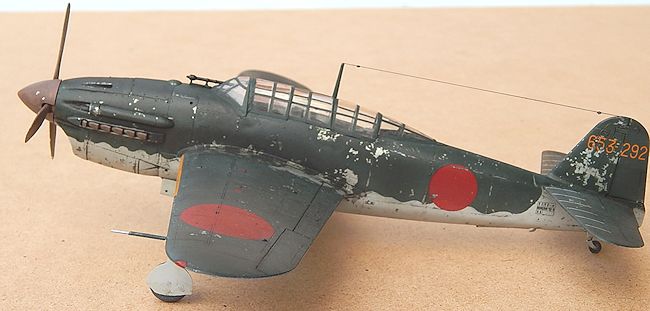 ouldn’t find
evidence of this, but looking at the kit, it shows a clear similarity with the
famed “Hasegawa Touch”: clean, crisp molding, detail where it matters,
relatively low parts count, ease of assembly. The Judy was their first 1/48
effort, and in spite of this, it’s still a very good kit. The fuselage layout
allows the installation of both types of engine (in-line and radial). Early
boxes included white metal parts, which have been replaced by styrene in later
issues.
ouldn’t find
evidence of this, but looking at the kit, it shows a clear similarity with the
famed “Hasegawa Touch”: clean, crisp molding, detail where it matters,
relatively low parts count, ease of assembly. The Judy was their first 1/48
effort, and in spite of this, it’s still a very good kit. The fuselage layout
allows the installation of both types of engine (in-line and radial). Early
boxes included white metal parts, which have been replaced by styrene in later
issues.
Transparencies are of excellent quality, but the canopy can only be represented closed. Only issue are the too-shallow landing gear wells, a frequent one in Japanese kits – but as the detail is nicely done, a good paint job will do the trick.
| CONSTRUCTION |
 The cockpit comes first (surprise, surprise) and, though it doesn’t reach
Hasegawa levels of accuracy (especially when the subject is a Japanese
aircraft), is adequately detailed. Its single shortcoming is that its assembly
is a bit sketchy and a few more locating slots would be welcome. However it
turns out OK. The underside of said cockpit unit forms the interior of the bomb
bay, which can be represented open (I chose this option). Next internal part
prior to main assembly is the radiator unit, which comes into the nose part.
After doing this, the airframe assembles in a few minutes
The cockpit comes first (surprise, surprise) and, though it doesn’t reach
Hasegawa levels of accuracy (especially when the subject is a Japanese
aircraft), is adequately detailed. Its single shortcoming is that its assembly
is a bit sketchy and a few more locating slots would be welcome. However it
turns out OK. The underside of said cockpit unit forms the interior of the bomb
bay, which can be represented open (I chose this option). Next internal part
prior to main assembly is the radiator unit, which comes into the nose part.
After doing this, the airframe assembles in a few minutes
Thanks to the very good fit and clever layout, only a little putty is necessary along the main joints. After the usual sanding (and re-scribing) session, the Judy is ready for painting.
| COLORS & MARKINGS |
It’s known that Japanese paint, especially during the final
war years, was of awful quality and chipped off very quickly. As my
documentation showed heavily weathered Judys, I decided to have a first go at
the now famous “salt method”. To those unaware of it, it’s quite simple: paint
the aircraft (or at least the areas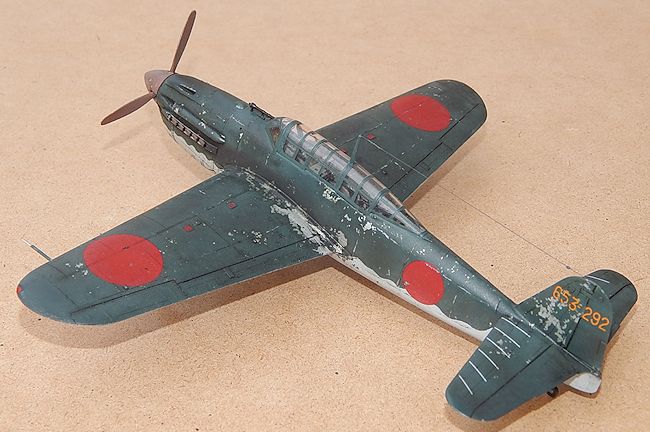 you want chipped) in metal, wet said areas,
drop salt (thick sea salt works best) over the model (especially at the wing
roots). When dry, airbrush the camo paint, wait, then wipe away the salt with a
brush. The result is very realistic (and if you have chipped too much, you still
can paint over some spots).
you want chipped) in metal, wet said areas,
drop salt (thick sea salt works best) over the model (especially at the wing
roots). When dry, airbrush the camo paint, wait, then wipe away the salt with a
brush. The result is very realistic (and if you have chipped too much, you still
can paint over some spots).
As for the scheme, it’s IJN dark green / IJN grey (or metal). Nothing very original here, the only difference between the various versions being the color of the spinner and the tail number, and the most remarkable feature of the Suisei’s camo scheme being the wavy delimitation between the upper and lower color, which looks pretty good IMO.
Once the plane painted, coated and decaled, I sealed off the surfaces with a further gloss coat and applied my usual wash of water-soluble oils.
| FINAL CONSTRUCTION |
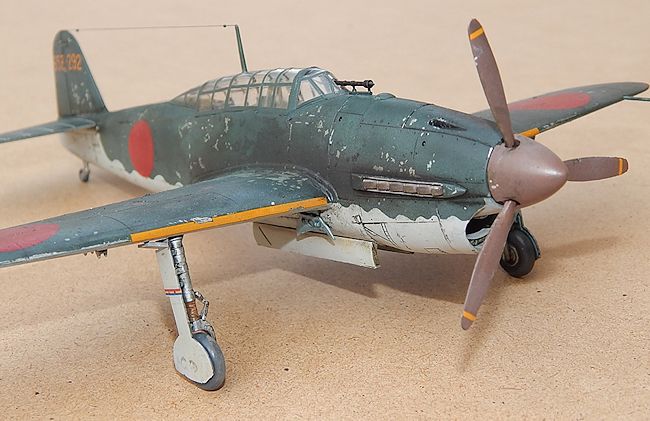 As polishing off the oil wash with soft paper would certainly take its toll on
the small external parts, these are added afterwards – there aren’t a lot on
this model: the landing gear, bomb bay doors, the propeller and spinner (all
painted separately). When these were firmly glue into position, I added a last
bit thinned oils to make them fit the aircraft’s general aspect, and added a
final coat of satin, enhanced here and there with a little gloss (I don’t like
all too uniform surfaces).
As polishing off the oil wash with soft paper would certainly take its toll on
the small external parts, these are added afterwards – there aren’t a lot on
this model: the landing gear, bomb bay doors, the propeller and spinner (all
painted separately). When these were firmly glue into position, I added a last
bit thinned oils to make them fit the aircraft’s general aspect, and added a
final coat of satin, enhanced here and there with a little gloss (I don’t like
all too uniform surfaces).
Transparencies were added last, the framing job being done with pre-painted decal stripes, as usual. Don’t forget the little window aft of the bomb bay doors!
Lastly, the antenna mast and pitot tube were added, with a stretched-sprue antenna wire and white glue isolators.
| CONCLUSIONS |
At the end of a trouble-free build, you get a very nice, clean and convincing representation of a lesser-known Japanese dive-bomber, and also a rather rarely-encountered piece to grace your collection of planes of the Rising Sun (mine must be the only Fine Molds Judy I have seen built outside the Internet). I say: highly recommended, as you can easily imagine. The kit has been regularly re-issued, is currently available and as the Judy is a small aircraft roughly the size of a P-40, it won’t take too much space on your shelves – go for it.
| REFERENCES |
Aircraft Profile #241 “Aichi D3A “Val” & Yokosuka D4y “Judy” Carrier Bombers of the IJNAF
Bunrin-Do #44 “Famous Airplanes of the World (December 1973) “Kugisho Carrier Dive Bomber “Suisei”
Monogram Close-Up #14&15: Japanese Cockpit Interiors parts I+II - various Internet sources.
Pierre-André Boillat
September 2015 If you would like your product reviewed fairly and
fairly quickly, please
contact
the editor or see other details in the
Note to
Contributors.